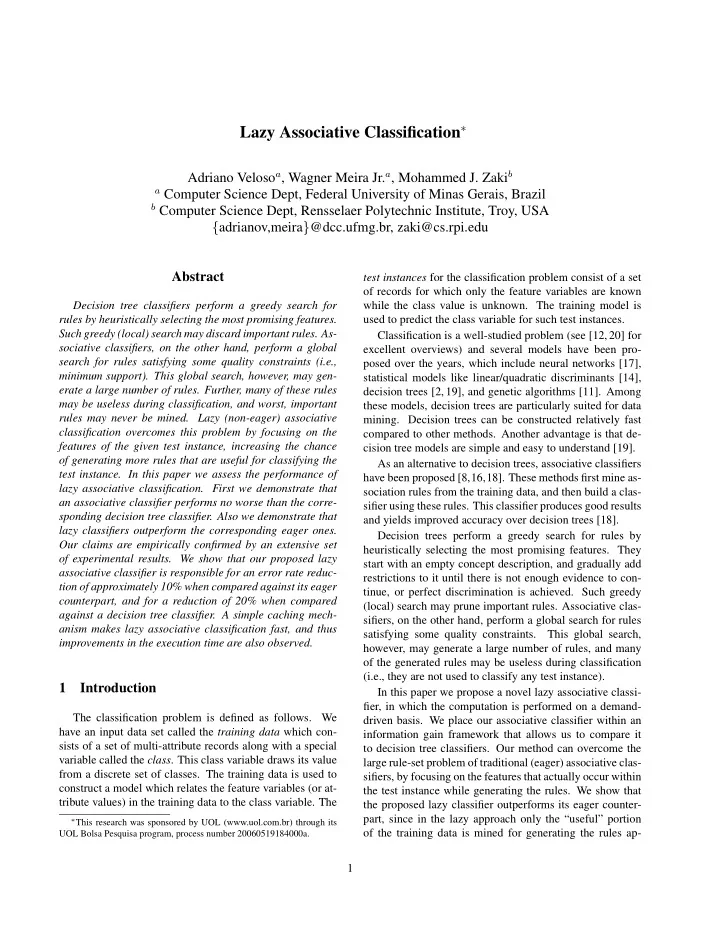

Lazy Associative Classification ∗ Adriano Veloso a , Wagner Meira Jr. a , Mohammed J. Zaki b a Computer Science Dept, Federal University of Minas Gerais, Brazil b Computer Science Dept, Rensselaer Polytechnic Institute, Troy, USA { adrianov,meira } @dcc.ufmg.br, zaki@cs.rpi.edu Abstract test instances for the classification problem consist of a set of records for which only the feature variables are known Decision tree classifiers perform a greedy search for while the class value is unknown. The training model is rules by heuristically selecting the most promising features. used to predict the class variable for such test instances. Such greedy (local) search may discard important rules. As- Classification is a well-studied problem (see [12,20] for sociative classifiers, on the other hand, perform a global excellent overviews) and several models have been pro- search for rules satisfying some quality constraints (i.e., posed over the years, which include neural networks [17], minimum support). This global search, however, may gen- statistical models like linear/quadratic discriminants [14], erate a large number of rules. Further, many of these rules decision trees [2, 19], and genetic algorithms [11]. Among may be useless during classification, and worst, important these models, decision trees are particularly suited for data rules may never be mined. Lazy (non-eager) associative mining. Decision trees can be constructed relatively fast classification overcomes this problem by focusing on the compared to other methods. Another advantage is that de- features of the given test instance, increasing the chance cision tree models are simple and easy to understand [19]. of generating more rules that are useful for classifying the As an alternative to decision trees, associative classifiers test instance. In this paper we assess the performance of have been proposed [8,16,18]. These methods first mine as- lazy associative classification. First we demonstrate that sociation rules from the training data, and then build a clas- an associative classifier performs no worse than the corre- sifier using these rules. This classifier produces good results sponding decision tree classifier. Also we demonstrate that and yields improved accuracy over decision trees [18]. lazy classifiers outperform the corresponding eager ones. Decision trees perform a greedy search for rules by Our claims are empirically confirmed by an extensive set heuristically selecting the most promising features. They of experimental results. We show that our proposed lazy start with an empty concept description, and gradually add associative classifier is responsible for an error rate reduc- restrictions to it until there is not enough evidence to con- tion of approximately 10% when compared against its eager tinue, or perfect discrimination is achieved. Such greedy counterpart, and for a reduction of 20% when compared (local) search may prune important rules. Associative clas- against a decision tree classifier. A simple caching mech- sifiers, on the other hand, perform a global search for rules anism makes lazy associative classification fast, and thus satisfying some quality constraints. This global search, improvements in the execution time are also observed. however, may generate a large number of rules, and many of the generated rules may be useless during classification (i.e., they are not used to classify any test instance). 1 Introduction In this paper we propose a novel lazy associative classi- fier, in which the computation is performed on a demand- The classification problem is defined as follows. We driven basis. We place our associative classifier within an have an input data set called the training data which con- information gain framework that allows us to compare it sists of a set of multi-attribute records along with a special to decision tree classifiers. Our method can overcome the variable called the class . This class variable draws its value large rule-set problem of traditional (eager) associative clas- from a discrete set of classes. The training data is used to sifiers, by focusing on the features that actually occur within construct a model which relates the feature variables (or at- the test instance while generating the rules. We show that tribute values) in the training data to the class variable. The the proposed lazy classifier outperforms its eager counter- part, since in the lazy approach only the “useful” portion ∗ This research was sponsored by UOL (www.uol.com.br) through its of the training data is mined for generating the rules ap- UOL Bolsa Pesquisa program, process number 20060519184000a. 1
Recommend
More recommend